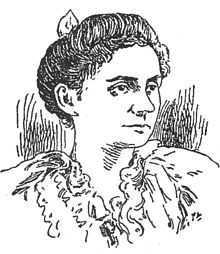Mary Proctor

| Wikisource has original text related to this article: |
Mary Proctor (1862 – September 11, 1957) was an American popularizer of astronomy.[1] She never became a professional astronomer but is widely known for numerous articles and books on the subject.[2] Despite various claims as being an American, there is a passenger list of about 1924 where she gives nationality as British.(ancestry.co Mary Proctor, passenger lists.
Early Life
She was born in Dublin, Ireland,[3] the daughter of Mary and Richard Proctor. Proctor's mother died in 1879. Her father remarried in 1881 and her family immigrated to the United States in Saint Joseph, Missouri in 1882.[3] Her father was a British popularizer of astronomy, lecturer, and writer, who was born in London and graduated Saint John's College in Cambridge. She gained her astronomical knowledge and love for writing from him. At early age, she took pride caring of her father's library and arranged his letters and corrected the galley proofs of his books. In 1898, Proctor graduated from the College of Preceptors in London.[2] The crater Proctor on the Moon was named after her and Proctor on Mars was named after her father.)[4][5]
Career
Proctor started assisting her father in the production of a new journal called Knowledge, which was edited and founded by her father. Her earliest publications was a series of articles on comparative mythology. Starting her secondary career as a lecturer on astronomy, Proctor followed a very successful appearance at the World's Columbian Exposition held in Chicago in 1893. Her first book Stories of Starland was published in 1898 which was adopted by the New York City Board of Education. She taught astronomy in private schools while attending the Columbia University.[2]
Works
Proctor authored many articles for newspapers, journals and published numerous popular books. Her articles and books were mostly aimed for young readers which made her known as the "children's astronomer." Her books were easy to read, accurate, informative and well illustrated. Widely respected by professional astronomers, Proctor was elected to a membership in the American Association for the Advancement of Science in 1898. In 1916, she was elected as a fellow of the Rpyal Astronomical Society.[2][6]
Bibliography
- Stories Of Starland, 1895.
- Giant Sun And His Family, 1896.
- "Halley's Comet after 75 years rushes Earthward again", San Francisco Call, August 23, 1908.
- Half Hours With The Summer Stars, 1911.
- Legends Of The Stars, 1922.
- The Children's Book Of The Heavens, 1924.
- Evenings With The Stars, 1924.
- Legends Of The Sun And Moon, 1926.
- The Romance Of Comets, 1926.
- The Romance Of The Sun, 1927.
- The Romance Of The Moon, 1928.
- The Romance Of The Planets, 1929.
- Wonders Of The Sky, 1931.
- Our Stars Month By Month, 1937
- M. Proctor and A. C. D. Crommelin, Comets, 1937.
- Everyman's Astronomy 1939.
- Comets, Meteors And Shooting Stars, 1940.
References
- ↑ "Corresponding Member: Miss Mary Proctor". Retrieved 12 February 2015.
- ↑ 2.0 2.1 2.2 2.3 Moore, Patrick; Thomas Hockey; Katherine Bracher; Marvin Bolt et al. (2007). "Proctor, Mary". In Bracher, Katherine. The biographical encyclopedia of astronomers ([Online-Ausg.] ed.). New York, NY: Springer. ISBN 9780387304007.
- ↑ 3.0 3.1 Hoffleit, Dorrit (2001). "The Maria Mitchell Observatory--For Astronomical Research and Public Enlightenment" (PDF). The Journal of the American Association of Variable Star Observer 30 (1): 67.
- ↑ Autostar Suite Astronomer Edition. CD-ROM. Meade, April 2006.
- ↑ Saum, Lewis O. (February 1999). "The Proctor interlude in St. Joseph and in America: Astronomy, romance and tragedy" (PDF). American Studies International 37 (1): –54. Retrieved 24 May 2014.
- ↑ "Proceedings of The American Association for the Advancement of Science, August 1898". Retrieved 12 February 2015.
Further reading
- Creese, Mary R. S. (1998). Ladies in the laboratory? : American and British women in science, 1800-1900 : a survey of their contributions to research. Lanham, Md.: Scarecrow. pp. 236–238. ISBN 9780810832879.
- Lienhard, John H. "Episode no. 2681: Mary Proctor". Engines of our ingenuity. Houston Public Media. Retrieved 24 May 2014.
External links
|